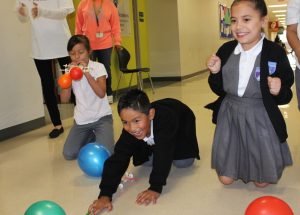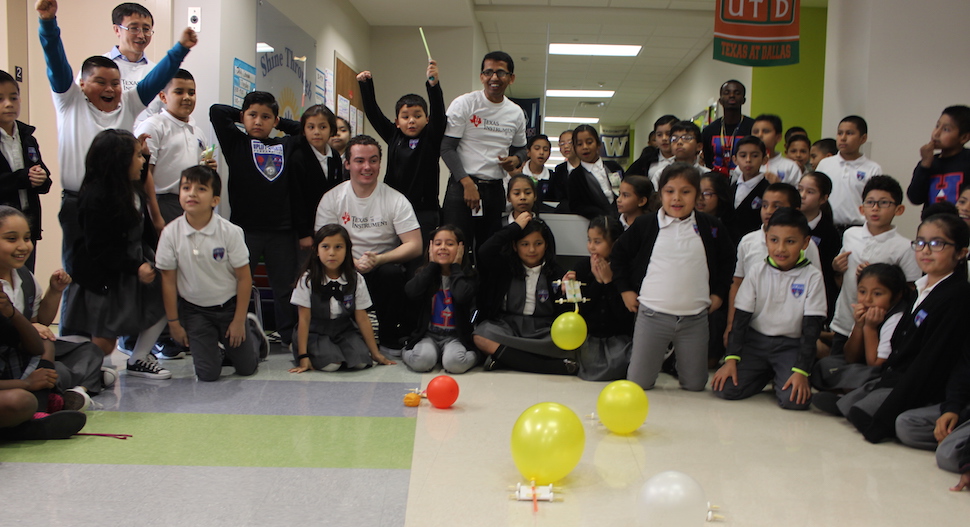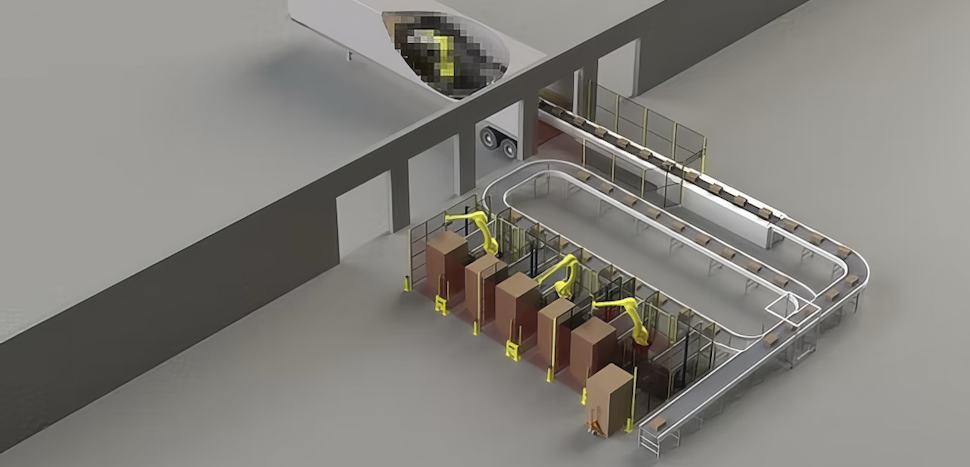Dallas Afterschool has long touted the benefits kids receive from having quality out-of-school time programming.
Now, Christina Hanger, CEO of Dallas Afterschool and fellow of Dallas Public Voices has the local research to back up that talk. And, thanks to an Inspire analysis can definitively say after-school programming costs about $3 per student per hour.
The 10-year-old agency provides a backbone of support for more than 130 nonprofit after-school and summer program sites in Dallas County with a focus on those serving low-income neighborhoods.
“These are people trying to do good things for kids, but running on very small budgets and without professional development for their staff, and without a lot of resources,” Hanger said.

Dallas Afterschool offers about 32 different hands-on Wonder Kit lessons mostly focused on science, technology, engineering, and math subjects. [Photo courtesy of Dallas Afterschool]
Recent findings from a multi-year study performed by Southern Methodist University’s Simmons School of Education and Human Development shows kids in Dallas Afterschool’s partner programs have higher standardized test scores in math and reading than those in other after-school programs.
“We are pretty excited to now be able to say, ‘yeah we know how much it costs, we’ve got some ideas on how you would scale it, and we know that it does make a difference,’” Hanger said.
With that knowledge, Hanger will guide Dallas Afterschool into its next decade with a keen eye on expanding access to area programs and in helping nonprofits grow.
Hanger said there’s enough capacity for 25 percent of Dallas County children to be in after-school programs, but only 4 percent of available seats are in free or low-cost programs.
In the next five years, she wants the number of seats to double for low-income kids.
Dallas Innovates caught up with Hanger recently to talk more about the SMU research, how the agency has evolved over its 10-year history, and what new initiatives are in the works. Her answers have been edited for brevity and clarity.
Tell me about Dallas Afterschool. How does it fit into Dallas’ educational landscape?
Afterschool has three major things that it does for families and children.
One, it keeps kids safe between the hours of 3 and 6 p.m. because 60 percent of moms work outside the home and there would be no one there to take care of the children.
Second, it helps working parents. National research would say parents miss eight days of work a year for out-of-school time child care. So, [afterschool] helps family productivity.
By the time kids are 11, middle class children have had 6,000 more hours of learning experiences than low-income kids.
The other thing is, quality after school [programming] really helps children thrive. It helps them academically. The national research would say they do better in school, they have better attendance, and they have fewer behavior programs.
Specifically, when we look at after school we see this dichotomy.
Middle-class families can pay for after-school programs. It might not be after school every day, it might be enrichment, piano lessons, karate and sports leagues, and all those kinds of things. They’re able to put together, based on the children’s interests, programs that meet their needs.
For low-income families, that’s not as easy to do. What we see is, by the time kids are 11, middle-class children have had 6,000 more hours of learning experiences than low-income kids. That gap continues to grow and two-thirds of it is after-school and summer experiences.
Children only spend 20 percent of their waking hours in the classroom when you think about the evenings and the weekends, and summer. So, when you’re talking about how do we educate our children, those hours become critically important. That’s why after school matters.
How has your work evolved over the years?
We work with all sorts of providers. We work with providers that have pretty different types of programming and we are pretty agnostic about that. We know after school can be quality regardless of the programming whether it’s more academic, sports-based, faith-based, or it’s arts-based. All of those can be good for kids.
In the beginning, we started 10 years ago as a convening, getting people together, offering training those types of things. Then, after a few years, the national research was coming out more and more about the importance of quality. So, we developed a quality assessment tool and we began working with fewer partners trying to work on quality improvement.
We know after school can be quality regardless of the programming whether it’s more academic, sports-based, faith-based, or it’s arts-based.
Now, as we are entering our second decade, we’ve also started to look at the access issues. There’s one issue around making sure that all kids, regardless of income and neighborhood, have access to quality after-school and summer programs.
In what ways has Dallas Afterschool adapted to meet the changes in education?
We’ve always kind of trained and coached around how do you generally run an after-school or summer program regardless of what kind of activities or programming you’re providing in it.
There’s a lot of after-school and summer programs focused on literacy. Well, literacy is not easy to do with kids. So, we’ve developed much more in-depth training for after-school providers on both literacy enrichment as well as literacy intervention.
We’ve also seen in some of the neighborhoods we work in, some of the children are growing up in some extreme levels of poverty. What Momentous Institute calls the “toxic stress of poverty.” So, we’ve started to roll out much more social emotional learning, support for the staff as well as kids, and curriculum and training in that area.
And then, the last one, where we see people have different interests is around STEM, whether it’s curriculum for STEM or staff training for how to do hands-on engaging science kind of lesson that kids just think is fun and don’t realize they’re learning.
Can you tell me about findings from the SMU research?
We see two big findings on the academic side.
The quality of the after-school site explains a significant amount of the variability in one-year literacy gains for first- and second-graders. The higher the quality of the site, the more the students improve in literacy.
Another way to say it is a small increase in the after-school program really goes a long way in making a bigger increase in early learners.
When we drill down further into it, what seems to make the biggest difference in those cases is how well the after-school and school programs are working together and communicating.
… what seems to make the biggest difference in those cases is how well the after-school program and the school program are working together and communicating.
That can be very easy to do if you are on the school premise. If you’re not, and you’re in a community center, does the after-school site know what’s going on at school, will the school teacher call the after-school staff and say, ‘can you work on this?’ Do they see report cards? Are they working on things kids need? Is the after-school program a support for the school as well?
It doesn’t mean that the after-school program looks like school, but is there good communication between the after school, the school, and the parents.
When we look at kids in our after-school programs versus other after-school programs, we’re seeing that our students are seeing overall improvements in math and reading [standardized testing scores] compared to students that aren’t in our programs. They are pretty large statistical differences.
For first- and second-graders, they are improving in math and reading at significant levels. In the upper grades, especially fifth grade, they are seeing major improvements for kids after school.
How has technology impacted curriculum over the years?
Not as much as you would think or what we would want. It depends on where the after-school program is. If they are in a community center, they may or may not have a computer lab. If they’re operating on school property, they may not have access to a computer lab. Some do and integrate it.
We have a volunteer that’s doing some work with Google Classroom and Google Virtual Reality and some other aspects of that. We are going to pilot that in an after-school program to see how do you use virtual reality in after school as a learning vehicle? That’s really brand new to us.
What is a Wonder Kit? How many students have y’all reached with them?
This is basically an after-school lesson in a box. It’s readily available materials.
Wonder Kits are our way [to allow] after-school staff, who may be a volunteer or may not be education trained, to be able to do a hands-on learning activity with kids that they are going to think is fun and they’ve learned something, but they don’t feel like they’re learning.
This is basically an after-school lesson in a box.
We now have about 32 different lessons most of them are STEM. They are tied to TEKS and we’ve also tied them to Common Core as well. It’s something that program staff can pick up. We provide them free for our partners.
There’s a lesson plan and there’s actually a link to a video that they can go watch and in five minutes they’re ready, prepared, and kids can come in and they can run this learning activity.
We have things they can build such as catapults and bridges. One of our newest ones is on Lunar Lander. We’ve done these kinds of things to make hands-on learning accessible to people.
In this last year, we’ve actually provided [Wonder Kits] to 20,000 kids in North Texas. We also now sell these outside of North Texas as a way for us to make some money for the agency to be able to provide them free for kids here. In the last 18 months, we’ve sold enough to reach 20,000 children as well.
Dallas Afterschool is celebrating 10 years this year, going forward what are some of the milestones you hope to reach five, 10 years down the road?
We would like to raise the public awareness of the importance of out-of-school time — after school and summer. There’s been a tremendous change in public perception around pre-K and early childhood and the importance of it. In the next five years, we’d like to see the same understanding of how important out-of-school time is for children.
Certainly, we are building that case of why it matters and why it’s good for kids. To that, I would like to see that there’s more access for underserved children.
Another way to think of it is, we know every day in Dallas County between the hours of 3 and 6 p.m. there’s over 100,000 children by themselves that are between the ages of 5-14. That is a serious problem. It’s serious for working parents. It’s serious for kids becoming victims of perpetrators. It could be bullying, vandalism, shoplifting— it can be all sorts of things. But, those things don’t lead any place good.
We would like to raise the public awareness of the importance of out-of-school time — after school and summer.
The other thing is, those are hours they could be getting engaging activities to help them learn. It wouldn’t look like school, but things that help kids know what they like and get excited about it.
So, five years from now, we would love to see the number of seats for low-income kids in our community double. That’s a huge number. From our cost analysis [we know] that’s a $25-30 million a year number. There’s not enough private money to be able to do that, so we’ve got to build awareness for why this matters in order to get public interest in providing it.
BY THE NUMBERS
100,000 Dallas County children, ages 5-14, are by themselves between the hours of 3 and 6 p.m. each day
20,000 kids were reached in the last year with Dallas Afterschool’s hands-on learning Wonder Kits
6,000 is the number of additional hours of learning experiences middle-class children have compared to those from low-income neighborhoods by age 11
800 for-profit and nonprofit after-school programs in Dallas County
130 after-school and summer program sites served by Dallas Afterschool
40 percent of children in Dallas County grow up in poverty
25 percent capacity for after-school programming seats in Dallas County
20 percent of waking hours are spent in the classroom by children
4 percent capacity for free or low-cost after-school programming seats in Dallas County
Delivering what’s new and next in Dallas-Fort Worth innovation, every day. Get the Dallas Innovates e-newsletter.






























